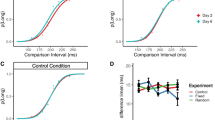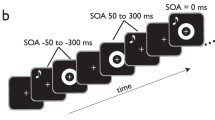Abstract
Training-induced improvements on perceptual skills can be attributed to at least two learning types: learning of general aspects of the trained condition (conceptual learning) and learning of specific feature values of the stimulus used in training (stimulus learning). Here we asked whether conceptual and stimulus learning on interaural time difference (ITD) discrimination emerge along different time courses. Conceptual learning was clearly evident 10 h after training, when performance on a target ITD condition was equivalent following training on that condition or on a non-target condition differing only in the stimulus, and was better in both cases than immediately after training. In contrast, stimulus learning emerged 24 h after training. At that time, performance on the target ITD condition was better following target- than non-target training, due to a worsening in performance between 10 and 24 h after non-target training rather than from additional improvements over this time period after target training. Training amount influenced performance immediately, but not 10 or 24 h, after training. Thus, conceptual learning emerged before stimulus learning, and each manifested through different improvement trajectories many hours after training. These results suggest that on ITD discrimination, conceptual learning is consolidated earlier, and with different behavioral consequences, than stimulus learning.






Similar content being viewed by others
References
Ahissar M, Hochstein S (1996) Learning pop-out detection: specificities to stimulus characteristics. Vision Res 36:3487–3500
Ahissar M, Hochstein S (1997) Task difficulty and the specificity of perceptual learning. Nature 387:401–406
Albouy G, Ruby P, Phillips C, Luxen A, Peigneux P, Maquet P (2006) Implicit oculomotor sequence learning in humans: time course of offline processing. Brain Res 1090:163–171
Amitay S, Irwin A, Moore DR (2006) Discrimination learning induced by training with identical stimuli. Nat Neurosci 9:1446–1448
Balas M, Roitenberg N, Giladi N, Karni A (2007) When practice does not make perfect: well-practiced handwriting interferes with the consolidation phase gains in learning a movement sequence. Exp Brain Res 178:499–508
Bernstein LR, Trahiotis C, Hyde EL (1998) Inter-individual differences in binaural detection of low-frequency or high-frequency tonal signals masked by narrow-band or broadband noise. J Acoust Soc Am 103:2069–2078
Casco C, Campana G, Gidiuli O (2001) Stimulus-specific dynamics of learning in conjunction search tasks. Vis Cogn 8:145–162
Censor N, Karni A, Sagi D (2006) A link between perceptual learning, adaptation and sleep. Vision Res 46:4071–4074
Chou I, Vaina LM (1995) 2-Dimensional symmetrical form discrimination—fast learning, but not that fast. Synthese 104:33–41
Cleveland W (1979) Robust locally weighted regression and smooth scatterplots. J Am Stat Assoc 74:829–836
Cohen J (1988) Statistical power analysis for the behavioral sciences. L. Erlbaum Associates, Hillsdale
Cohen DA, Pascual-Leone A, Press DZ, Robertson EM (2005) Off-line learning of motor skill memory: a double dissociation of goal and movement. Proc Natl Acad Sci USA 102:18237–18241
Delhommeau K, Micheyl C, Jouvent R, Collet L, Micheyl (2002) Transfer of learning across durations and ears in auditory frequency discrimination. Percept Psychophys 64:426–436
Delhommeau K, Micheyl C, Jouvent R (2005) Generalization of frequency discrimination learning across frequencies and ears: implications for underlying neural mechanisms in humans. Jaro J Assoc Res Otolaryngol 6:171–179
Demany L (1985) Perceptual learning in frequency discrimination. J Acoust Soc Am 78:1118–1120
Demany L, Semal C (2002) Learning to perceive pitch differences. J Acoust Soc Am 111:1377–1388
Dezazzo J, Tully T (1995) Dissection of memory formation—from behavioral pharmacology to molecular-genetics. Trends Neurosci 18:212–218
Dudai Y (2004) The neurobiology of consolidations, or, how stable is the engram? Annu Rev Psychol 55:51–86
Fahle M, Edelman S, Poggio T (1995) Fast perceptual learning in hyperacuity. Vision Res 35:3003–3013
Fiorentini A, Berardi N (1980) Perceptual learning specific for orientation and spatial frequency. Nature 287:43–44
Fischer S, Hallschmid M, Elsner AL, Born J (2002) Sleep forms memory for finger skills. Proc Natl Acad Sci USA 99:11987–11991
Folkard S (1979) Time of day and level of processing. Mem Cogn 7:247–252
Goedert KM, Miller J (2008) Spacing practice sessions across days earlier rather than later in training improves performance of a visuomotor skill. Exp Brain Res 189:189–197
Harris JA, Harris IM, Diamond ME (2001) The topography of tactile learning in humans. J Neurosci 21:1056–1061
Hauptmann B, Karni A (2002) From primed to learn: the saturation of repetition priming and the induction of long-term memory. Cogn Brain Res 13:313–322
Hauptmann B, Reinhart E, Brandt SA, Karni A (2005) The predictive value of the leveling off of within-session performance for procedural memory consolidation. Cogn Brain Res 24:181–189
Jacoby WG (2000) Loess: a nonparametric, graphical tool for depicting relationships between variables. Elect Stud 19:577–613
Karni A, Sagi D (1993) The time course of learning a visual skill. Nature 365:250–252
Karni A, Meyer G, Rey-Hipolito C, Jezzard P, Adams MM, Turner R, Ungerleider LG (1998) The acquisition of skilled motor performance: fast and slow experience-driven changes in primary motor cortex. Proc Natl Acad Sci USA 95:861–868
Korman M, Raz N, Flash T, Karni A (2003) Multiple shifts in the representation of a motor sequence during the acquisition of skilled performance. Proc Natl Acad Sci USA 100:12492–12497
Korman M, Doyon J, Doljansky J, Carrier J, Dagan Y, Karni A (2007) Daytime sleep condenses the time course of motor memory consolidation. Nat Neurosci 10:1206–1213
Levitt H (1971) Transformed up-down methods in psychoacoustics. J Acoust Soc Am 49:467–477
Liu ZL, Weinshall D (2000) Mechanisms of generalization in perceptual learning. Vision Res 40:97–109
McGaugh JL (2000) Neuroscience—memory—a century of consolidation. Science 287:248–251
Mednick SC, Arman AC, Boynton GM (2005) The time course and specificity of perceptual deterioration. Proc Natl Acad Sci USA 102:3881–3885
Mednick SC, Drummond SPA, Boynton GM, Awh E, Serences J (2008) Sleep-dependent learning and practice-dependent deterioration in an orientation discrimination task. Behav Neurosci 122:267–272
Monk TH, Leng VC (1982) Time of day effects in simple repetitive tasks—some possible mechanisms. Acta Psychol 51:207–221
Murphy KR, Myors B (2004) Statistical power analysis : a simple and general model for traditional and modern hypothesis tests. Lawrence Erlbaum, Mahwah
Ofen-Noy N, Dudai Y, Karni A (2003) Skill learning in mirror reading: how repetition determines acquisition. Cogn Brain Res 17:507–521
Ortiz JA, Wright BA (2009) Contributions of procedure and stimulus learning to early, rapid perceptual improvements. J Exp Psychol Hum Percept Perform 35:188–194
Poggio T, Fahle M, Edelman S (1992) Fast perceptual learning in visual hyperacuity. Science 256:1018–1021
Press DZ, Casement MD, Pascual-Leone A, Robertson EM (2005) The time course of off-line motor sequence learning. Cogn Brain Res 25:375–378
Recanzone GH, Schreiner CE, Merzenich MM (1993) Plasticity in the frequency representation of primary auditory cortex following discrimination training in adult owl monkeys. J Neurosci 13:87–103
Robertson EM, Pascual-Leone A, Press DZ (2004) Awareness modifies the skill-learning benefits of sleep. Curr Biol 14:208–212
Robinson K, Summerfield AQ (1996) Adult auditory learning and training. Ear Hear 17:S51–S65
Roth DAE, Kishon-Rabin L, Hildesheimer M, Karni A (2005) A latent consolidation phase in auditory identification learning: time in the awake state is sufficient. Learn Mem 12:159–164
Rubin N, Nakayama K, Shapley R (1997) Abrupt learning and retinal size specificity in illusory-contour perception. Curr Biol 7:461–467
Savion-Lemieux T, Penhune VB (2005) The effects of practice and delay on motor skill learning and retention. Exp Brain Res 161:423–431
Song SB, Howard JH, Howard DV (2007) Sleep does not benefit Probabilistic motor sequence learning. J Neurosci 27:12475–12483
Sowden P, Davies I, Rose D, Kaye M (1996) Perceptual learning of stereoacuity. Perception 25:1043–1052
Walker MP (2005) A refined model of sleep and the time course of memory formation. Behav Brain Sci 28:51–104
Wright BA, Fitzgerald MB (2001) Different patterns of human discrimination learning for two interaural cues to sound-source location. Proc Natl Acad Sci USA 98:12307–12312
Wright BA, Sabin AT (2007) Perceptual learning: how much daily training is enough? Exp Brain Res 180:727–736
Zhang YX, Wright BA (2007) Similar patterns of learning and performance variability for human discrimination of interaural time differences at high and low frequencies. J Acoust Soc Am 121:2207–2216
Zhang YX, Wright BA (2009) An influence of amplitude modulation on interaural level difference processing suggested by learning patterns of human adults. J Acoust Soc Am 126:1349–1358
Acknowledgments
This work was supported by the National Institutes of Health/National Institute for Deafness and Other Communication Disorders.
Author information
Authors and Affiliations
Corresponding author
Rights and permissions
About this article
Cite this article
Ortiz, J.A., Wright, B.A. Differential rates of consolidation of conceptual and stimulus learning following training on an auditory skill. Exp Brain Res 201, 441–451 (2010). https://doi.org/10.1007/s00221-009-2053-5
Received:
Accepted:
Published:
Issue Date:
DOI: https://doi.org/10.1007/s00221-009-2053-5




